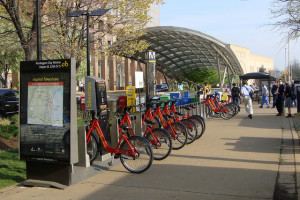How is marketing evolving, and what is the future of marketing?
This is the question that was at the core of a presentation by Mitch Joel, a digital marketer who spends a lot of time looking at where the profession is going and how companies can position themselves to take advantage of trends at the bleeding edge. Which probably explains why I’m a big fan of his and why Joel’s Six Pixels of Separation is the only marketing blog I always make the time to read.
In his presentation for MarketingProfs, Joel tackled businesses’ top challenges, what customers want, and why he thinks content is not the future. Here are my top takeaways on the future of marketing.
Be digital at your core.
Joel said that too many companies still think of digital as an add-on, as though slapping a mobile skin on your Web site will solve all your problems. It won’t. Joel talked about the need for companies to become “mobile first” and to bake into their cores the need to think, speak, and act digital.
Take Snapchat, an app I’ve been playing around with lately.
Joel points out that Snapchat is digital at its core because it is:
- image-based visual
- highly social
- made for mobile (first)
Joel added that it introduced a new form of communications: snaps are (theoretically) impermanent. Because who really wants everything we say to be remembered forever?
Think access, not ownership.

There’s a lot of buzz about the sharing economy, a concept I haven’t written about much because I’m not comfortable with the conventional narrative about what it is or what it means. (Okay, that probably means there’s a blog post TBD.) Joel asked a slightly different question: what do consumers really want to own?
Indeed, we are increasingly paying for access rather than ownership. Music (e.g., Spotify) and movies (e.g., Netflix) are the most obvious examples. But “sharing” is another form. Think Zipcar, Capital Bikeshare, or breather.
How can your business position itself for this shift?
Your hub is no longer The Hub.

I’ve talked a lot about the importance of your Web site, the place where you own your algorithms. But this is changing. With Instant Articles, for example, major publishers are ceding hub status to Facebook. Twitter is adding “buy” buttons. Joel noted that Ikea built a Web site on Instagram. The point is that increasingly it’s not about driving traffic to your site but thinking through how you can connect with — and sell to — customers where they are. (But don’t dismantle your Web site just yet because it is still important.)
The future is ubiquitous connectivity.
If you read this blog regularly, you know that digital ubiquity is something I’ve been thinking about for a while. The connectedness of technologies and devices will accelerate this trend. Joel suggested that into this digital-everywhere world the next digital consumer will actually be a “quantified consumer.” As the Garmin Vivofit on my wrist attests, many of us are already tracking information about our behavior and our health. Soon our refrigerators will tell us when we are running low on eggs and we’ll be able to hit a buy button on the cabinet door to order more coffee.

Think this is fiction? Amazon already offers Dash Buttons to its Prime members.
Brands will move beyond the channel-based world.
Joel posited a content hierarchy in which content is merely the baseline. It’s the cost of entry, because without it you have no raison d’etre to blog or be on anyone’s platform. (Well, unless you’re still just “selling” — but that would be pretty stupid.)
If content is the baseline, the next level is channels. Facebook is a channel. So are Twitter, YouTube, Periscope, and much of what fits into “traditional” social media. You friend / follow someone. You see their content.
The next step, says Joel, is networks.

Joel pointed to Amazon’s $1.1 billion purchase of Twitch, an online network where people watch people play different video games. (When the sale took place, I didn’t get it though I am smart enough to know that Amazon is a smart company. I still don’t get it, but after listening to Joel talk about this stuff I’m beginning to see a little light.)
It’s like flipping a TV remote. Change the channel and you access different content and a whole new community. The barrier to entry isn’t who you know or who you follow. It just is. I’m still trying to wrap my brain around the idea, so I’m not ready to picture a strategy for any given industry or company — let alone what the content distribution or revenue model might be. But it is, indeed, food for thought.
Hub by Andrew Fogg (Flickr); Bikes by mariordo59 (Flickr).



